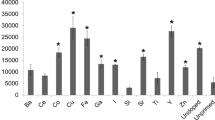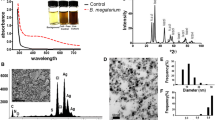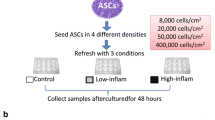Abstract
A bioactive borate glass, 13-93B3 (B3), has been used successfully in the clinic to treat chronic, nonhealing wounds without scarring. However, the mechanism by which B3 stimulates wound healing is poorly understood. Because adipose stem cells (ASCs) have been shown to have multiple roles in wound repair, we hypothesized that B3 triggers ASCs. In this study, we evaluate the effects of B3 on ASC survival, migration, differentiation, and protein secretion in vitro. In concentrations ≤10 mg/ml, B3 did not affect ASC viability under static conditions. B3 promoted the migration of ASCs but did not increase differentiation into bone or fat. B3 also decreased ASCs secretion of collagen I, PAI-1, MCP-1, DR6, DKK-1, angiogenin, IL-1, IGFBP-6, VEGF, and TIMP-2; increased expression of IL-1R and E-selectin; had a transient decrease in IL-6 secretion; and had a transient increase in bFGF secretion. Together, these results show that B3 alters the protein secretion of ASCs.







Similar content being viewed by others
Abbreviations
- ASC:
-
Adipose stem cells
- B3:
-
Borate bioactive glass
- CCM:
-
Complete culture medium
- ECM:
-
Extracellular matrix
- VEGF:
-
Vascular endothelial growth factor
- bFGF:
-
Basic fibroblast growth factor
- TIMP-2:
-
Tissue inhibitor of metalloproteinases
- IGFBP:
-
Insulin-like growth factor-binding protein 6
- IL-1:
-
Interleukin 1
- IL-6:
-
Interleukin 6
- PAI:
-
Plasminogen activator inhibitor
- MCP:
-
Monocyte chemoattractant protein, also known as CCL2
- DR6:
-
Death receptor 6
- DKK-1:
-
Dickkopf-related protein 1
- PBS:
-
Phosphate buffer saline
References
Järbrink K, Ni G, Sönnergren H. Prevalence and incidence of chronic wounds and related complications: a protocol for a systematic review. Syst Rev. 2016;5. https://doi.org/10.1186/s13643-016-0329-y.
Sen CK. Human wounds and its burden: an updated compendium of estimates. Adv Wound Care. 2019;8:39–48. https://doi.org/10.1089/wound.2019.0946.
Wang P-H, Huang B-S, Horng H-C, et al. Wound healing. J Chinese Med Assoc. 2018;81:94–101. https://doi.org/10.1016/j.jcma.2017.11.002.
Shah J, Mohd Y, Omar E, Pai DR, Sood S. Cellular events and biomarkers of wound healing. Indian J Plast Surg. 2012;45:220–8. https://doi.org/10.4103/0970-0358.101282.
Mendonça RJ, de, Coutinho-Netto J. Cellular aspects of wound healing. Anais Brasileiros de Dermatol. 2009;84:257–62. https://doi.org/10.1590/S0365-05962009000300007.
Lombardi F, Palumbo P, Augello FR, et al. Secretome of adipose tissue-derived stem cells (ASCs) as a novel trend in chronic non-healing wounds: an overview of experimental in vitro and in vivo studies and methodological variables. Int J Mol Sci. 2019;20:3721 https://doi.org/10.3390/ijms20153721.
Cherubino M, Rubin JP, Miljkovic N, et al. Adipose-derived stem cells for wound healing applications. Ann Plast Surg. 2011;66:210–5. https://doi.org/10.1097/SAP.0b013e3181e6d06c.
Fromm-Dornieden C, Koenen P. Adipose-derived stem cells in wound healing: recent results in vitro and in vivo. OA Mol Cell Biol. 2013;1:8.
Chen S, Yang Q, Brow RK, et al. In vitro stimulation of vascular endothelial growth factor by borate-based glass fibers under dynamic flow conditions. Mater Sci Eng C Mater Biol Appl. 2017;73:447–55. https://doi.org/10.1016/j.msec.2016.12.099.
Gadelkarim M, Abushouk AI, Ghanem E, et al. Adipose-derived stem cells: effectiveness and advances in delivery in diabetic wound healing. Biomed Pharmacother. 2018;107:625–33. https://doi.org/10.1016/j.biopha.2018.08.013.
Li P, Guo X. A review: therapeutic potential of adipose-derived stem cells in cutaneous wound healing and regeneration. Stem Cell Res Ther. 2018;9. https://doi.org/10.1186/s13287-018-1044-5.
Strong AL, Bowles AC, MacCrimmon CP, et al. Adipose stromal cells repair pressure ulcers in both young and elderly mice: potential role of adipogenesis in skin repair. Stem Cells Transl Med. 2015;4:632–42. https://doi.org/10.5966/sctm.2014-0235.
Shingyochi Y, Orbay H, Mizuno H. Adipose-derived stem cells for wound repair and regeneration. Expert Opin Biol Ther. 2015;15:1285–92. https://doi.org/10.1517/14712598.2015.1053867.
D’Andrea F, De Francesco F, Ferraro GA, et al. Large-scale production of human adipose tissue from stem cells: a new tool for regenerative medicine and tissue banking. Tissue Eng Part C. 2008;14:233–42. https://doi.org/10.1089/ten.tec.2008.0108.
Casteilla L, Dani C. Adipose tissue-derived cells: from physiology to regenerative medicine. Diabetes Metab. 2006;32:393–401. https://doi.org/10.1016/s1262-3636(07)70297-5.
van Dongen JA, Harmsen MC, van der Lei B, Stevens HP. Augmentation of dermal wound healing by adipose tissue-derived stromal cells (ASC). Bioengineering. 2018;5. https://doi.org/10.3390/bioengineering5040091.
Miguez-Pacheco V, Hench LL, Boccaccini AR. Bioactive glasses beyond bone and teeth: emerging applications in contact with soft tissues. Acta Biomater. 2015;13:1–15. https://doi.org/10.1016/j.actbio.2014.11.004.
Hench LL. The story of Bioglass®. J Mater Sci. 2006;17:967–78. https://doi.org/10.1007/s10856-006-0432-z.
Kargozar S, Mozafari M, Hamzehlou S, Baino F. Using bioactive glasses in the management of burns. Front Bioeng Biotechnol. 2019;7:62. https://doi.org/10.3389/fbioe.2019.00062.
Brauer DS. Bioactive glasses—structure and properties. Angew Chemie Int Ed. 2015;54:4160–81. https://doi.org/10.1002/anie.201405310.
Naseri S, Lepry WC, Nazhat SN. Bioactive glasses in wound healing: hope or hype? J Mater Chem B. 2017;5:6167–74. https://doi.org/10.1039/C7TB01221G.
Kargozar S, Baino F, Hamzehlou S, et al. Bioactive glasses: sprouting angiogenesis in tissue engineering. Trends Biotechnol. 2018;36:430–44. https://doi.org/10.1016/j.tibtech.2017.12.003.
Lin Y, Brown RF, Jung SB, Day DE. Angiogenic effects of borate glass microfibers in a rodent model. J Biomed Mater Res A. 2014;102:4491–9. https://doi.org/10.1002/jbm.a.35120.
Jung SB, Day DE. Revolution in wound care? Inexpensive, easy-to-use cotton candy-like glass fibers appear to speed healing in initial venous stasis wound trial. Am Ceram Soc Bull. 2011;90:25–9.
Jung SB. Borate based bioactive glass scaffolds for hard and soft tissue engineering. Rolla, MO, USA: PhD Dissertation, Missouri University of Science and Technology; 2010.
Jung SB, Day DE. Wound Care Compositions. US patent 20170014542. 2017.
Balasubramanian P, Büttner T, Miguez Pacheco V, Boccaccini AR. Boron-containing bioactive glasses in bone and soft tissue engineering. J Eur Ceram Soc. 2018;38:855–69. https://doi.org/10.1016/j.jeurceramsoc.2017.11.001.
Zhao S, Li L, Wang H, et al. Wound dressings composed of copper-doped borate bioactive glass microfibers stimulate angiogenesis and heal full-thickness skin defects in a rodent model. Biomaterials. 2015;53:379–91. https://doi.org/10.1016/j.biomaterials.2015.02.112.
Yang Q, Chen S, Shi H, et al. In vitro study of improved wound-healing effect of bioactive borate-based glass nano-/micro-fibers. Mater Sci Eng C Mater Biol Appl. 2015;55:105–17. https://doi.org/10.1016/j.msec.2015.05.049.
Yao A, Wang D, Huang W, et al. In vitro bioactive characteristics of borate-based glasses with controllable degradation behavior. J Am Ceram Soc. 2007;90:303–6. https://doi.org/10.1111/j.1551-2916.2006.01358.x.
Zhou J, Wang H, Zhao S, et al. In vivo and in vitro studies of borate based glass micro-fibers for dermal repairing. Mater Sci Eng C Mater Biol Appl. 2016;60:437–45. https://doi.org/10.1016/j.msec.2015.11.068.
Bose S, Fielding G, Tarafder S, Bandyopadhyay A. Trace element doping in calcium phosphate ceramics to understand osteogenesis and angiogenesis. Trends Biotechnol. 2013;31: https://doi.org/10.1016/j.tibtech.2013.06.005.
Saghiri MA, Asatourian A, Orangi J, et al. Functional role of inorganic trace elements in angiogenesis-Part II: Cr, Si, Zn, Cu, and S. Crit Rev Oncol Hematol. 2015;96:143–55. https://doi.org/10.1016/j.critrevonc.2015.05.011.
Rath SN, Brandl A, Hiller D, et al. Bioactive copper-doped glass scaffolds can stimulate endothelial cells in co-culture in combination with mesenchymal stem cells. PLoS ONE. 2014;9:e113319. https://doi.org/10.1371/journal.pone.0113319.
Gupta B, Papke JB, Mohammadkhah A, et al. Effects of chemically doped bioactive borate glass on neuron regrowth and regeneration. Ann Biomed Eng. 2016;44:3468–77. https://doi.org/10.1007/s10439-016-1689-0.
Akdere ÖE, Shikhaliyeva İ, Gümüşderelioğlu M. Boron mediated 2D and 3D cultures of adipose derived mesenchymal stem cells. Cytotechnology. 2019;71:611–22. https://doi.org/10.1007/s10616-019-00310-9.
Brown RF, Rahaman MN, Dwilewicz AB, et al. Effect of borate glass composition on its conversion to hydroxyapatite and on the proliferation of MC3T3-E1 cells. J Biomed Mater Res Part A. 2009;88A:392–400. https://doi.org/10.1002/jbm.a.31679.
Modglin VC, Brown RF, Jung SB, Day DE. Cytotoxicity assessment of modified bioactive glasses with MLO-A5 osteogenic cells in vitro. J Mater Sci Mater Med. 2013;24:1191–9. https://doi.org/10.1007/s10856-013-4875-8.
Ojansivu M, Mishra A, Vanhatupa S, et al. The effect of S53P4-based borosilicate glasses and glass dissolution products on the osteogenic commitment of human adipose stem cells. PLoS ONE. 2018;13:e0202740. https://doi.org/10.1371/journal.pone.0202740.
Mahdavi FS, Salehi A, Seyedjafari E, et al. Bioactive glass ceramic nanoparticles-coated poly(l-lactic acid) scaffold improved osteogenic differentiation of adipose stem cells in equine. Tissue Cell. 2017;49:565–72. https://doi.org/10.1016/j.tice.2017.07.003.
Saçak B, Certel F, Akdeniz ZD, et al. Repair of critical size defects using bioactive glass seeded with adipose-derived mesenchymal stem cells. J Biomed Mater Res Part B Appl Biomater. 2017;105:1002–8. https://doi.org/10.1002/jbm.b.33634.
Larrañaga A, Alonso-Varona A, Palomares T, et al. Effect of bioactive glass particles on osteogenic differentiation of adipose-derived mesenchymal stem cells seeded on lactide and caprolactone based scaffolds. J Biomed Mater Res A. 2015;103:3815–24. https://doi.org/10.1002/jbm.a.35525.
Haimi S, Suuriniemi N, Haaparanta A-M, et al. Growth and osteogenic differentiation of adipose stem cells on PLA/bioactive glass and PLA/beta-TCP scaffolds. Tissue Eng Part A. 2009;15:1473–80. https://doi.org/10.1089/ten.tea.2008.0241.
Abdik EA, Abdik H, Taşlı PN, et al. Suppressive role of boron on adipogenic differentiation and fat deposition in human mesenchymal stem cells. Biol Trace Elem Res. 2019;188:384–92. https://doi.org/10.1007/s12011-018-1428-5.
Lin Q, Fang D, Fang J, et al. Impaired wound healing with defective expression of chemokines and recruitment of myeloid cells in TLR3-deficient mice. J Immunol. 2011;186:3710–7. https://doi.org/10.4049/jimmunol.1003007.
Cash JL, Martin P. Myeloid cells in cutaneous wound repair. Microbiol Spectr. 2016;4: https://doi.org/10.1128/microbiolspec.MCHD-0017-2015.
Akita S, Akino K, Hirano A. Basic fibroblast growth factor in scarless wound healing. Adv Wound Care. 2013;2:44–49. https://doi.org/10.1089/wound.2011.0324.
Barrientos S, Brem H, Stojadinovic O, Tomic-Canic M. Clinical application of growth factors and cytokines in wound healing. Wound Repair Regen. 2014;22:569–78. https://doi.org/10.1111/wrr.12205.
Przybylski M. A review of the current research on the role of bFGF and VEGF in angiogenesis. J Wound Care. 2009;18:516–9. https://doi.org/10.12968/jowc.2009.18.12.45609.
Zonari A, Martins TMM, Paula ACC, et al. Polyhydroxybutyrate-co-hydroxyvalerate structures loaded with adipose stem cells promote skin healing with reduced scarring. Acta Biomater. 2015;17:170–81. https://doi.org/10.1016/j.actbio.2015.01.043.
Hebert TL, Wu X, Yu G, et al. Culture effects of epidermal growth factor (EGF) and basic fibroblast growth factor (bFGF) on cryopreserved human adipose-derived stromal/stem cell proliferation and adipogenesis. J Tissue Eng Regen Med. 2009;3:553–61. https://doi.org/10.1002/term.198.
Lim CP, Phan TT, Lim IJ, Cao X. Cytokine profiling and Stat3 phosphorylation in epithelial-mesenchymal interactions between keloid keratinocytes and fibroblasts. J Invest Dermatol. 2009;129:851–61. https://doi.org/10.1038/jid.2008.337.
Gong Z-H, Ji J-F, Yang J, et al. Association of plasminogen activator inhibitor-1 and vitamin D receptor expression with the risk of keloid disease in a Chinese population. Kaohsiung J Med Sci. 2017;33:24–29. https://doi.org/10.1016/j.kjms.2016.10.013.
Patel S, Maheshwari A, Chandra A. Biomarkers for wound healing and their evaluation. J Wound Care. 2016;25:46–55. https://doi.org/10.12968/jowc.2016.25.1.46.
Yukami T, Hasegawa M, Matsushita Y, et al. Endothelial selectins regulate skin wound healing in cooperation with L-selectin and ICAM-1. J Leukoc Biol. 2007;82:519–31. https://doi.org/10.1189/jlb.0307152.
Liu ZJF, Tian R, An W, et al. Identification of E-selectin as a novel target for the regulation of postnatal neovascularization: implications for diabetic wound healing. Ann Surg. 2010;252:625–34. https://doi.org/10.1097/SLA.0b013e3181f5a079.
Bach LA. Recent insights into the actions of IGFBP-6. J Cell Commun Signal. 2015;9:189–200. https://doi.org/10.1007/s12079-015-0288-4.
Le AD, Zhang Q, Wu Y, et al. Elevated vascular endothelial growth factor in keloids: relevance to tissue fibrosis. Cells Tissues Organs. 2004;176:87–94. https://doi.org/10.1159/000075030.
DiPietro LA. Angiogenesis and wound repair: when enough is enough. J Leukoc Biol. 2016;100:979–84. https://doi.org/10.1189/jlb.4MR0316-102R.
Apdik H, Doğan A, Demirci S, Aydın S, Şahin F. Dose-dependent effect of boric acid on myogenic differentiation of human adipose-derived stem cells (hADSCs). Biol Trace Elem Res. 2015;165:123–30. https://doi.org/10.1007/s12011-015-0253-3.
Li X, Wang X, Jiang X, et al. Boron nitride nanotube-enhanced osteogenic differentiation of mesenchymal stem cells. J Biomed Mater Res B Appl Biomater. 2016;104:323–9. https://doi.org/10.1002/jbm.b.33391.
Shuai C, Gao C, Feng P, et al. Boron nitride nanotubes reinforce tricalcium phosphate scaffolds and promote the osteogenic differentiation of mesenchymal stem cells. J Biomed Nanotechnol. 2016;12:934–47.
Abdik EA, Abdik H, Taşlı PN, Deniz AAH, Şahin F. Suppressive role of boron on adipogenic differentiation and fat deposition in human mesenchymal stem cells. Biol Trace Elem Res. 2019;188:384–92. https://doi.org/10.1007/s12011-018-1428-5.
Demirci S, Doğan A, Şişli B, Sahin F. Boron increases the cell viability of mesenchymal stem cells after long-term cryopreservation. Cryobiology. 2014;68:139–46. https://doi.org/10.1016/j.cryobiol.2014.01.010.
Natesan S, Wrice NL, Baer DG, Christy RJ. Debrided skin as a source of autologous stem cells for wound repair. Stem Cells. 2011;29:1219–30. https://doi.org/10.1002/stem.677.
Gimble JM, Guilak F, Bunnell BA. Clinical and preclinical translation of cell-based therapies using adipose tissue-derived cells. Stem Cell Res Ther. 2010;1:19. https://doi.org/10.1186/scrt19.
Schäffler A, Büchler C. Concise review: adipose tissue-derived stromal cells–basic and clinical implications for novel cell-based therapies. Stem Cells. 2007;25:818–27. https://doi.org/10.1634/stemcells.2006-0589.
Lee RH, Hsu SC, Munoz J, et al. A subset of human rapidly self-renewing marrow stromal cells preferentially engraft in mice. Blood. 2006;107:2153–61. https://doi.org/10.1182/blood-2005-07-2701
Ylöstalo J, Bazhanov N, Prockop DJ. Reversible commitment to differentiation by human multipotent stromal cells (MSCs) in single-cell derived colonies. Exp Hematol. 2008;36:1390–402. https://doi.org/10.1016/j.exphem.2008.05.003.
Kilroy GE, Foster SJ, Wu X, et al. Cytokine profile of human adipose-derived stem cells: expression of angiogenic, hematopoietic, and pro-inflammatory factors. J Cell Physiol. 2007;212:702–9. https://doi.org/10.1002/jcp.21068.
Wulandari E, Jusman SWA, Moenadjat Y, et al. Expressions of collagen I and III in hypoxic keloid tissue. Kobe J Med Sci. 2016;62:E58–69.
da Silva IR, Tiveron LCR, da C, da Silva MV, et al. In situ cytokine expression and morphometric evaluation of total collagen and collagens type I and type III in keloid scars. Mediat Inflamm. 2017;2017:6573802. https://doi.org/10.1155/2017/6573802.
Tejiram S, Zhang J, Travis TE, et al. Compression therapy affects collagen type balance in hypertrophic scar. J Surg Res. 2016;201:299–305. https://doi.org/10.1016/j.jss.2015.10.040.
Xue M, Jackson CJ. Extracellular matrix reorganization during wound healing and its impact on abnormal scarring. Adv Wound Care. 2015;4:119–36. https://doi.org/10.1089/wound.2013.0485.
Gauglitz GG, Korting HC, Pavicic T, et al. Hypertrophic scarring and keloids: pathomechanisms and current and emerging treatment strategies. Mol Med. 2011;17:113–25. https://doi.org/10.2119/molmed.2009.00153.
Marieb EN, Smith LA Chapter 19: The cardiovascular system: blood vessels, human anatomy and physiology 11th ed. 2018. p. 706–65 London, England: Pearson.
Dimmeler S. ATVB in focus: novel mediators and mechanisms in angiogenesis and vasculogenesis. Arterioscler Thromb Vasc Biol. 2005;25:2245. https://doi.org/10.1161/01.ATV.0000187471.06942.17.
Heil M, Eitenmüller I, Schmitz-Rixen T, Schaper W. Arteriogenesis versus angiogenesis: similarities and differences. J Cell Mol Med. 2006;10:45–55. https://doi.org/10.1111/j.1582-4934.2006.tb00290.x.
Buschmann I, Schaper W. Arteriogenesis versus angiogenesis: two mechanisms of vessel growth. News Physiol Sci. 1999;14:121–5. https://doi.org/10.1152/physiologyonline.1999.14.3.121.
Sohni A, Verfaillie CM. Mesenchymal stem cells migration homing and tracking. Stem Cells Int. 2013;2013:130763. https://doi.org/10.1155/2013/130763.
De Becker A, Riet IV. Homing and migration of mesenchymal stromal cells: how to improve the efficacy of cell therapy. World J Stem Cells. 2016;8:73–87. https://doi.org/10.4252/wjsc.v8.i3.73.
Nitzsche F, Müller C, Lukomska B, et al. Concise review: MSC adhesion cascade-insights into homing and transendothelial migration. Stem Cells. 2017;35:1446–60. https://doi.org/10.1002/stem.2614.
Lin W, Xu L, Zwingenberger S, et al. Mesenchymal stem cells homing to improve bone healing. J Orthop Translat. 2017;9:19–27. https://doi.org/10.1016/j.jot.2017.03.002.
Naderi MH, Matin MM, Heirani‐Tabasi A, et al. Injectable hydrogel delivery plus preconditioning of mesenchymal stem cells: exploitation of SDF-1/CXCR4 axis toward enhancing the efficacy of stem cells’ homing. Cell Biol Int. 2016;40:730–41. https://doi.org/10.1002/cbin.10474.
Frazier T, Lee S, Bowles A, et al. Gender and age-related cell compositional differences in C57BL/6 murine adipose tissue stromal vascular fraction. Adipocyte. 2018;7:183–9. https://doi.org/10.1080/21623945.2018.1460009.
Zhang X, Bowles AC, Semon JA. Transplantation of autologous adipose stem cells lacks therapeutic efficacy in the experimental autoimmune encephalomyelitis model. PLoS ONE. 2014;9: https://doi.org/10.1371/journal.pone.0085007.
Scruggs BA, Semon JA, Zhang X, et al. Age of the donor reduces the ability of human adipose-derived stem cells to alleviate symptoms in the experimental autoimmune encephalomyelitis mouse model. Stem Cells Transl Med. 2013;2:797–807. https://doi.org/10.5966/sctm.2013-0026.
Strong AL, Strong TA, Rhodes LV, et al. Obesity associated alterations in the biology of adipose stem cells mediate enhanced tumorigenesis by estrogen dependent pathways. Breast Cancer Res. 2013;15:R102. https://doi.org/10.1186/bcr3569.
Pandey AC, Semon JA, Kaushal D, et al. MicroRNA profiling reveals age-dependent differential expression of nuclear factor κB and mitogen-activated protein kinase in adipose and bone marrow-derived human mesenchymal stem cells. Stem Cell Res Ther. 2011;2:49. https://doi.org/10.1186/scrt90.
Deshmane SL, Kremlev S, Amini S, Sawaya BE. Monocyte chemoattractant protein-1 (MCP-1): an overview. J Interferon Cytokine Res. 2009;29:313–26. https://doi.org/10.1089/jir.2008.0027.
Fujikura D, Ikesue M, Endo T, et al. Death receptor 6 contributes to autoimmunity in lupus-prone mice. Nat Commun. 2017;8:13957. https://doi.org/10.1038/ncomms13957.
Kasof GM, Lu JJ, Liu D, et al. Tumor necrosis factor-alpha induces the expression of DR6, a member of the TNF receptor family, through activation of NF-kappaB. Oncogene. 2001;20:7965–75. https://doi.org/10.1038/sj.onc.1204985.
Rabieian R, Boshtam M, Zareei M, et al. Plasminogen activator inhibitor type-1 as a regulator of fibrosis. J Cell Biochem. 2018;119:17–27. https://doi.org/10.1002/jcb.26146.
Brosius FC. New insights into the mechanisms of fibrosis and sclerosis in diabetic nephropathy. Rev Endocr Metab Disord. 2008;9:245–54. https://doi.org/10.1007/s11154-008-9100-6.
Choi SH, Kim H, Lee HG, et al. Dickkopf-1 induces angiogenesis via VEGF receptor 2 regulation independent of the Wnt signaling pathway. Oncotarget. 2017;8:58974–84. https://doi.org/10.18632/oncotarget.19769.
Author information
Authors and Affiliations
Contributions
Conceived and designed the experiments: DED, JAS; Data curation: Cell culture: LCG, NJT; Live/dead + analysis: BAB; CyQuant: BAB, LCG; Migration: LCG; Invasion: LCG; Differentiation: NJT; Alkaline Phosphatase: LCG; Immunocytochemistry: NJT; Bio-Rad: LCG; Formal analysis: NJT, LCG, BAB; Contributed reagents/materials/analysis tools: DED; Wrote - original draft: NJT, JAS; Writing - reviewing and editing: NJT, BAB, LCG, LEF, DED, JAS.
Corresponding author
Ethics declarations
Conflict of interest
The authors declare that they have no conflict of interest.
Additional information
Publisher’s note Springer Nature remains neutral with regard to jurisdictional claims in published maps and institutional affiliations.
Rights and permissions
About this article
Cite this article
Thyparambil, N.J., Gutgesell, L.C., Bromet, B.A. et al. Bioactive borate glass triggers phenotypic changes in adipose stem cells. J Mater Sci: Mater Med 31, 35 (2020). https://doi.org/10.1007/s10856-020-06366-w
Received:
Accepted:
Published:
DOI: https://doi.org/10.1007/s10856-020-06366-w




